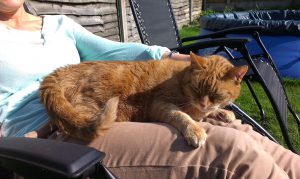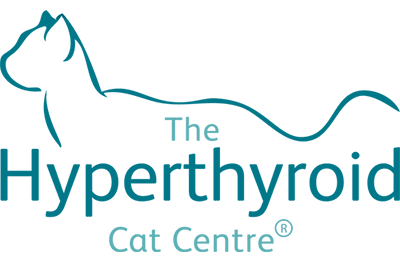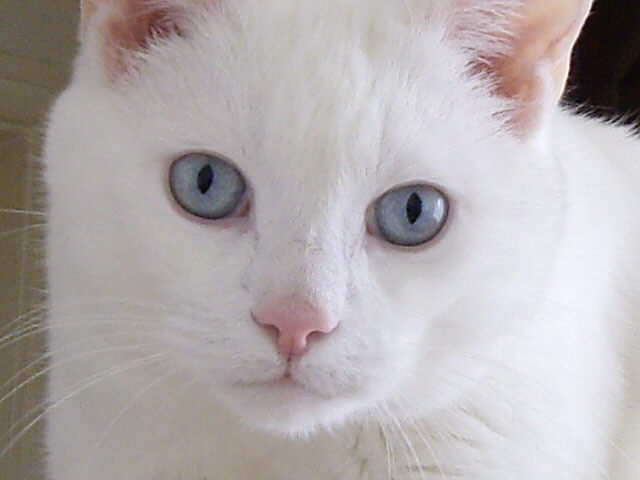After Radio-Iodine
After radio-iodine treatment, your cat should be cured of hyperthyroidism. But they’ll need careful handling for a while, to keep everyone safe.
Cats who have been treated with radio-iodine therapy will remain radioactive for a period of time, and that’s why great care needs to be taken.

Cosmo is happy to be home and back on his owners lap, now he is no longer radioactive.
How will your cat respond to treatment?
Most hyperthyroid cats respond fully to a single radio-iodine capsule or injection. Their hyperthyroidism won’t come back, and they don’t need ongoing medication. Most cats respond to treatment within weeks, although some take up to 6 months to gain the full benefit. However, that may not be the case in a very small number of cats.
- Under 1% of cats treated with radio-iodine will still be hyperthyroid 6 months later. If this is the case with your cat, we will access your cat’s suitablity for a second treatment (within your initial fee) which will almost certainly provide the cure.
- However, a very small proportion still won’t respond, and we wouldn’t normally offer a third treatment. These cats may have a cancerous thyroid tumour, and would need significantly higher doses of radio-iodine before they would respond.
- Some cats are very sensitive to radio-iodine, and may go the other way – becoming hypothyroid, where thyroid hormone levels are too low. This usually self-corrects in time. Some will remain hypothyroid with no apparent ill-effects, but around 2% will develop clinical signs such as weight gain, coat changes, personality changes and perhaps excessive drinking. Hypothyroidism is easily treatable.
What about taking your cat home?
- For the homeward journey, we’ll use Feliway Transport or Pet Remedy ahead of your discharge appointment. We can also starve your cat if it’s likely to get car sick; just let us know.
- Please don’t bring children with you to collect your cat, and if you are (or could be) pregnant, please arrange for someone else to come on your behalf.
- Once at home, your cat can come into contact other pets (we have guidelines for this), and your treated cat’s moulting hair is not itself radioactive unless contaminated with urine or faeces.
How long will your cat be radioactive?
After radio-iodine treatment all cats will return to normal (“background radiation”) by 28 days. Cats can be discharged from the Centre from 4 days after treatment, although this depends on exactly how much radio-iodine is given and on how quickly the radiation levels fall. This shortest time is based on direct measurement of radiation levels and cannot be reliably predicted. After this time advice falls into two blocks:
Up to 14 days after treatment it is important to do the following:
We give much more detailed guidance in our free booklet, Hyperthyroidism in Cats, but in summary, for the first 2 weeks:
- Keep young children away from your cat at all times. Keep your cat in a room on their own the whole time, to which only designated carers should have access. Consider using door locks, if appropriate. If contact does occur to someone other than the carer, thoroughly clean for example the child’s hands (or wherever contact occurred). If a child and the cat are to be in adjacent rooms, please discuss with us what the wall is made of, and how far apart they will be.
- Anyone of child-bearing age should have no contact with your cat or with your cat’s litter tray. This ensures that anyone who is or may be pregnant is kept away from radioactivity.
- Do not spend more than a few minutes at a time in close proximity to your cat. It is safe to handle your cat but avoid close contact such as hugs or sitting on your lap. Your cat must not have access to your bedroom.
- Always wash your hands thoroughly after handling your cat, and especially before you eat or drink.
- Avoid face-to-face contact and don’t let your cat lick you.
- Prevent your cat from having access to kitchen surfaces or anywhere where food is stored or prepared. If this does happen, clean the surface carefully before using it again.
- Contact between your cat and other pets at home is not problematic to them, so long as it doesn’t compromise your ability to control where your treated cat is. Read our detailed guidelines about how to handle soiled cat litter in our free booklet.
Between 15 and 28 days:
In most cases it is not necessary to keep your cat in a separate room. If you have children at home or visiting, your cat should be kept in a separate room to which children have no access. If children are inaccessible in your home (eg during school hours, or overnight), then your cat does not require to be kept in a separate room at these times.
- Your cat must not share bedrooms with people and should be kept off kitchen surfaces.
- Prevent your cat from having access to kitchen surfaces or anywhere where food is stored or prepared. If this does happen, clean the surface carefully before using it again.
- Contact between your cat and other pets at home is not problematic to them, so long as it doesn’t compromise your ability to control where your treated cat is.
- As a guide, during days 15 – 21 your cat could spend an hour a day sitting on your lap, increasing to 2 hours a day during days 22 – 28.
- After 28 days no restrictions apply and your cat can be treated and handled as usual.

Charlie enjoying the great outdoors in his very smart harness whilst waiting for the last of the radiation to ebb away
What about follow-ups with your vet?
After their radio-iodine treatment, your cat will need some monitoring from your own vet – such as periodic clinical examinations, blood and urine tests, and blood pressure estimation. Typically we’d recommend these at 6 weeks, 3 months and 6 months after treatment, but they can vary between cats (and vets!) and aren’t compulsory.


